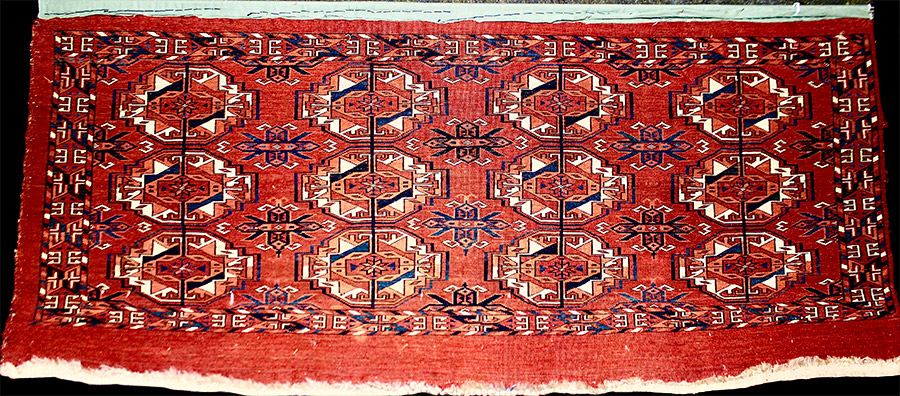Clay Stewart Collection of Türkmen Textiles
(17) 12-Gül Ahal Téké Türkmen Tor:ba
Ca. 1860. Size: 3 ft. 9 in. x 1 ft. 7 in.
Ca. 1860. Size: 3 ft. 9 in. x 1 ft. 7 in.

Full Frontal View

Full Back View
Original back missing. Knot count: 13 width by 24 in height = 312 asymmetrical knots per square inch, pulled open to the right, resulting in a medium handle. 2 ivory blonde weft shoots, Z-plied together are virtually invisible from the back, partly wefting shows a single shoot and another show a double weft, the 3 blonde shoots in the warp are S- plied. Knot warp nodes are extraordinary even when viewed from back (although some areas have a slight ridge). A bottom row of knots are large supplementary (added on) symmetrical (Turkish) knots, cut down to their transverse shoots. Both top and bottom flat woven ends show two stripes (red & ivory) where it's turned over and sewn down. There is lovely abrash throughout the field.
2 parallel ala ja strips cross the horizontal opening top opening lip of the bag face. Then 12 primary cü:wal güls in 4 columns of 3 each, are each bisected by a vertical blue line (Ahal Téké feature, Ref. Moshkova) connecting a grid through the center of each cü:wal gül. Then 6 complete and 14 partially hidden minor secondary Çemçe ornaments. The main border is repeated classic sacred Saryk tridents (aka, the ancient Peikam ornament which goes back to at least 13th century China, Ref. Turkmen Studies I) alternating with atanak gochanak variants and flanked on each side by gyak strips as the narrow minor guard borders’ pattern.
This specimen is a superbly wrought fabric with a sumptuously velvety pile. The minute knots are delicately and extraordinarily evenly woven as viewed from the back. This is the mark of a very mature and experienced weaver. The face of the fabric has a velvety soft feel to the touch. The pile wool is combed and dyed primarily with an orangey red (a common Ahal Téké color, Ref. Moshkova) that glows like embers in a fire. Its table top is cropped perfectly even with a medium height giving just enough wool to glow. The use of a Saryk trident major border ornament is unusual for the Ahal Téké ( more commonly used in Saryk tor:ba borders) otherwise this rug is classic Ahal Téké weaving. The rug is in superb condition with the exception of its re-cast sides.
The Ahal Oasis Atock, second half of the 19th century. This land was known as Daman-I-Kuh or ’skirt of the hills' and extended from Kizil Arvat to Gawars on the northern slope of the Kopet Dag mountains and is bordered on the other side by the great Gara Gum desert.